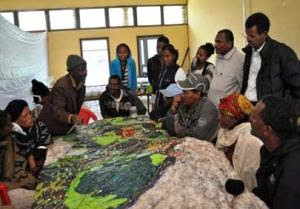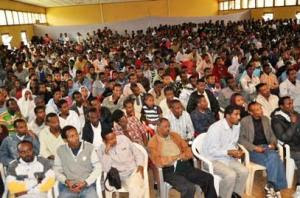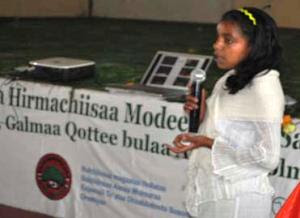The first ever training kit for Participatory Spatial Information Management and Communication was launched today after weeks of excited pre-ordering online. Co-published by CTA and IFAD, this training kit is a unique product that can be tailored to meet the learning needs of the individual, group or organisation.
‘This is a hugely exciting training tool for the development sector,’ commented Giacomo Rambaldi, Senior Programme Coordinator at CTA. ‘It means that employees can now get the best available training tailored to meet their individual needs.’
The training kit comprises 15 modules, each presented through a series of units. They cover the entire spectrum of good developmental practice. The modules deal with topics such as fundamentals of training, ethics and community groundwork and processes as well as the more technical low-, mid- and high-tech participatory mapping methods.
The Training Kit is featured on the CTA Publications catalogue. Available in English and Spanish, it is aimed at technology intermediaries working in multidisciplinary teams, and for those required to deliver training on the practice or facilitate the process in the field.
The benefits of this type of mapping are numerous. Mapmaking is considered as a step in a broader process resulting in community empowerment by adding value and authority to local spatial knowledge. The process leading to the production of maps is in fact more important than the outputs themselves, as knowledge holders learn by doing. The practice is motivating and often leads to stronger identity and cohesion among community members. Moreover, maps are a powerful and convincing medium which can be used to effectively convey local concerns and aspirations to decision- and policy makers.
This project is another example of CTA’s dedication to empowering rural communities through knowledge. The success of the training kit also demonstrates the benefits CTA enjoys through working with partners such as IFAD to deliver high quality information to a wider audience.
If you are interested in getting a copy of the Training Kit you may send an e-mail to Murielle Vandreck vandreck@cta.int adding PGIS-TK (English / Spanish) to the e-mail subject line.
Online versions: coming soon
DVD versions: CTA online catalogue
Showing posts with label educational. Show all posts
Showing posts with label educational. Show all posts
Friday, December 10, 2010
Friday, October 23, 2009
Dr. Robert Chambers elaborates on Participatory GIS (PGIS) practice
Dr. Robert Chambers from the Institute of Development Studies (IDS), UK, reflects on the intersection of participatory development and Geographic Information Systems (GIS) and on the resulting good and bad practices. In the interview Dr. Chambers calls on practitioners and development agencies to ensure that good practice is put in place to avoid the repetition of the misuse of PRA (i.e. Participatory Rural Appraisal) done in the 80's and 90's.
Labels:
educational,
ethics,
indigenous mapping,
indigenous peoples,
mapping,
p3dm,
participation,
participatory,
Participatory GIS,
participatory mapping,
pgis,
PGIS2005,
ppgis,
Robert Chambers
Sunday, October 04, 2009
Participatory 3D Model of the historical Wechecha mountain complex, Ethiopia
 MELCA Mahiber, an Ethiopian NGO which is part of the African Biodiversity Network (ABN) facilitated the construction of a Participatory 3 Dimensional Model (P3DM) of the historical Wechecha mountain complex, which is found in Oromiya Regional State, adjacent to Wolmera and Sebeta Awas Woreda in Ethiopia.
MELCA Mahiber, an Ethiopian NGO which is part of the African Biodiversity Network (ABN) facilitated the construction of a Participatory 3 Dimensional Model (P3DM) of the historical Wechecha mountain complex, which is found in Oromiya Regional State, adjacent to Wolmera and Sebeta Awas Woreda in Ethiopia.Once completed the model has been inaugurated by a Representative of the President of Federal Democratic Republic of Ethiopia. Over 500 people participated in the ceremony including members of the House of People Representative Councils, governmental officials and representatives from international organizations, CSO and local communities.
 The 1:10.000 scale model covers an area of 24 km by 28 km. Over 40 students and representatives from youth groups constructed the blank model. Residents of the area, especially elders, were invited to populate the map with their spatial knowledge. In the process information about the mountain area has been shared across generations and between local communities and other stakeholders, opening the door for deeper discussions on the sustainable management and safeguarding of both local culture and environment. The local Governors were very supportive. They played an active role in the process together with the organisers.
The 1:10.000 scale model covers an area of 24 km by 28 km. Over 40 students and representatives from youth groups constructed the blank model. Residents of the area, especially elders, were invited to populate the map with their spatial knowledge. In the process information about the mountain area has been shared across generations and between local communities and other stakeholders, opening the door for deeper discussions on the sustainable management and safeguarding of both local culture and environment. The local Governors were very supportive. They played an active role in the process together with the organisers.The objective of the exercise was to document the Traditional Ecological Knowledge (TEK) of resident communities, and add value and authority to it in order to increase the value external authorities would attach to it when it comes to collaborative natural resource management. A second objective of the exercise was to enhance the transfer of TEK the younger generations.
Now thet the model is completed it will as a reference environment where local people, government officials and other stakeholders can discuss management and rehabilitation plans.
 Kalkidan is a 15-year old student at Holeta Primary School. She witnessed how this model created an opportunity for her and her friends to learn a lot from the local elders. At the inauguration she stated the following: “We youngsters didn’t think that elders know, but now, after participating in the construction of this Participatory 3 Dimensional Model, we are convinced that our elders have a deep knowledge about their environment” She recalled that the elders were the main actors on the scene.
Kalkidan is a 15-year old student at Holeta Primary School. She witnessed how this model created an opportunity for her and her friends to learn a lot from the local elders. At the inauguration she stated the following: “We youngsters didn’t think that elders know, but now, after participating in the construction of this Participatory 3 Dimensional Model, we are convinced that our elders have a deep knowledge about their environment” She recalled that the elders were the main actors on the scene. At the ceremony Elders locaed their places of origin on the model and talked about them. They couldn’t hide their feeling that their area is becoming degraded and pleaded for concerned bodies to address this problem. The government representatives also endorsed the model and reiterated that it should not be just for looking at and admiring.”
At the ceremony Elders locaed their places of origin on the model and talked about them. They couldn’t hide their feeling that their area is becoming degraded and pleaded for concerned bodies to address this problem. The government representatives also endorsed the model and reiterated that it should not be just for looking at and admiring.”Dr. Tewoldebithan G/Egziabher, Director of the Federal Environmental Protection Authority and Chairman of MELCA’s General Assembly delivered the model to Holeta Town and Wolmera Woreda Administrations on behalf of MELCA. He told to the Administrations to use the model as a reference for taking measures.
According to Million Belay the Director of MELCA related initiatives will follow: There will be an intensive planning process aiming at rehabilitating the Wechecha Mountain complex and we will ensure that the model will be central to it. Schools located at the foothills of the mountain will make use of the model in their curriculum like it is currently happening in Nessuit Kenya, where a similar model has been constructed in 2006. Teachers use it to facilitate pupils learning about their environment, geography and cultural landscapes. In addition, Mr. Belay stated that the 3D model will be used for scientific research, on the relationship between people and the environment, and to study the impacts of land degradation on the livelihood of local communities.
Labels:
Africa,
educational,
environmental,
Ethiopia,
mapping,
maps,
p3dm,
pgis,
ppgis,
Wechecha
Wednesday, September 16, 2009
Head teacher Julius Sangogo reports on the usefullness of a Participatory 3D Model (P3DM) in Nessuit, Kenya
Head teacher Julius Sangogo reports on the usefullness of a Participatory 3D Model in Nessuit, Kenya from CTA on Vimeo.
Three years after the completion of a Participatory 3D model in Nessuit Kenya, head teacher Julius Sangogo recalls the uses of the model by local, national and international agencies and more importantly by the pupils of the local primary school.
Subscribe to:
Posts (Atom)

